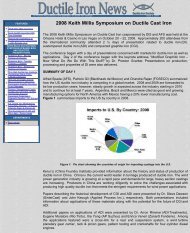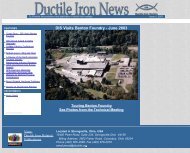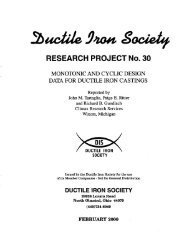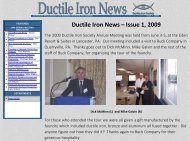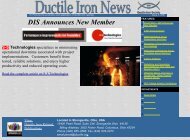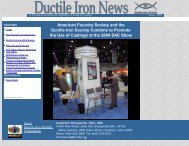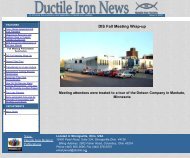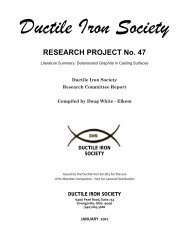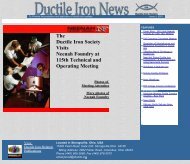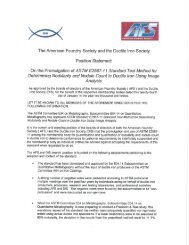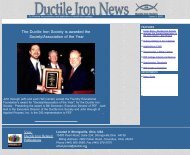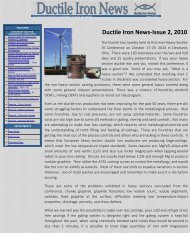You also want an ePaper? Increase the reach of your titles
YUMPU automatically turns print PDFs into web optimized ePapers that Google loves.
Figure 3a (upper). Transition zone of welded ASTM A539 grade 60-40-18 ductile iron illustrating the structure of the base metal (top<br />
portion of the photomicrograph) the transition zone and the weld fusion zone (lower portion of the photomicrograph).<br />
Figure 3b (lower). Weld fusion zone of ASTM A539 grade 60-40-18 ductile iron.<br />
ASTM A536 Grade 120-90-02. Tensile properties of welded and unwelded ductile irons produced to this grade of ductile iron are also shown in<br />
Table III. The properties of the unwelded and welded samples are similar and represent acceptable<br />
ductile iron, although one of the welded samples is softer with lower strengths likely due to the high nodule count of the weld metal.<br />
ASTM A439 Modified. Tensile test coupons taken from exemplar welded ASTM A439 Grade D5B modified ductile iron resulted in the data shown<br />
in Table III. It is apparent that the tensile properties of these two test bars did not meet the minimum values required in ASTM A439 Grade D5B,<br />
having been low in elongation and borderline in tensile strength, but quite adequate in yield strength. This is attributed to the aforementioned<br />
carbide network developed, primarily in the zone of partial fusion, due to the introduction of Mo in the modified version of this alloy. The<br />
enhancement of this network in the partial fusion zone resulted in decreased elongation and tensile strength which was not evident in either<br />
separately cast test bars or in test bars machined from casting sections.<br />
Table III. Tensile Properties of Welded ASTM A536 <strong>Ductile</strong> <strong>Iron</strong>2<br />
TS Ksi YS ksi El % HB<br />
As Cast Unwelded 87.6 68.4 8.0 217<br />
As Cast Welded 84.4 67.2 5.0 223<br />
As Cast Welded 86.2 67.8 6.0 223<br />
Annealed Unwelded 65.2 47.8 19.0 156<br />
Annealed Welded 66.4 46.0 16.0 149<br />
Annealed Welded 62.6 48.2 14.5 143<br />
Normalized Unwelded 93.4 76.4 4.0 235<br />
Normalized Welded 97.2 77.0 4.0 241<br />
Normalized Welded 100.2 78.2 3.5 255<br />
Q&T (1000F) Unwelded 121.6 90.8 2.5 302<br />
Q&T (1000F) Welded 117.2 87.2 3.5 269<br />
Q&T (1000F) Welded 120.2 91.4 2.0 293<br />
Table IV. Tensile Properties of Welded ASTM A439 Modified <strong>Ductile</strong> <strong>Iron</strong><br />
Dia. in. Area sq. in.<br />
Tensile Load, Yield Load,<br />
lb.<br />
lb.<br />
T.S. ksi Y.S. ksi El. %<br />
0.500 0.1963 10,600 7,460 54.5 38.0 3.0<br />
0.499 0.1956 10,790 7,250 55.0 37.1 4.0<br />
Summary<br />
The ductile iron welding procedure described is a process applicable to the salvage of ductile iron castings, or to the joining of ductile iron<br />
components, resulting in machinable ductile iron microstructures in the weld metal, zone of partial fusion and base metal. Similar tensile properties<br />
in the weld metal, partial fusion zone and base metal could be expected if the microstructures are adequately controlled. However, it is anticipated<br />
that most applications of these casting repair procedures will be non-structural and will provide machinable material with a color match of the<br />
original casting.<br />
Acknowledgements<br />
The authors wish to thank others at Oil City <strong>Iron</strong> Works, Inc. for their support and assistance in the development and application of ductile iron



